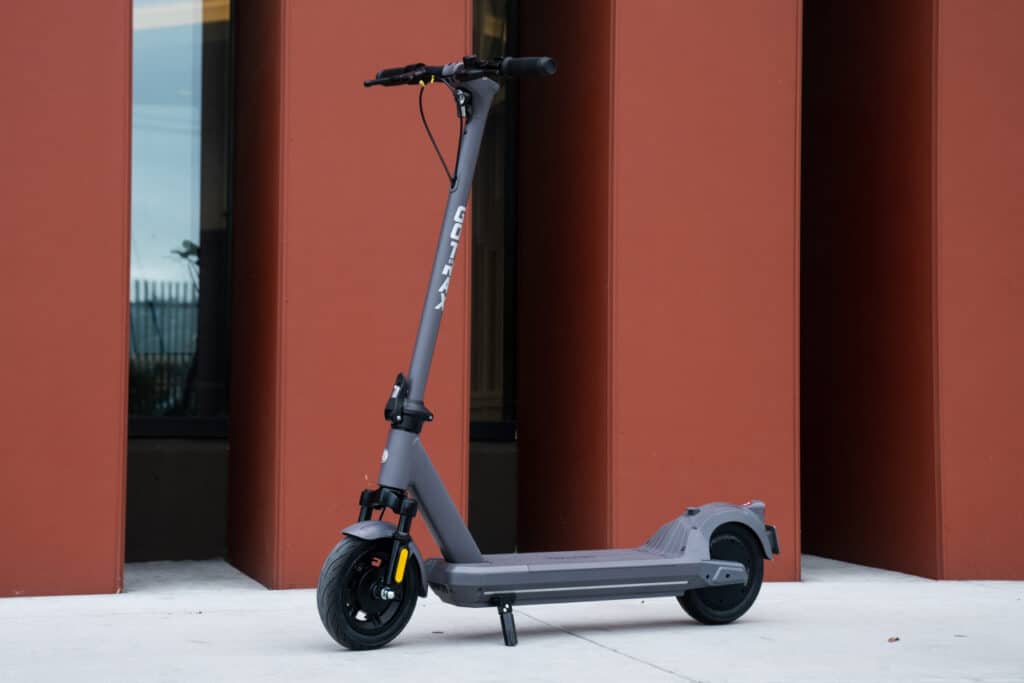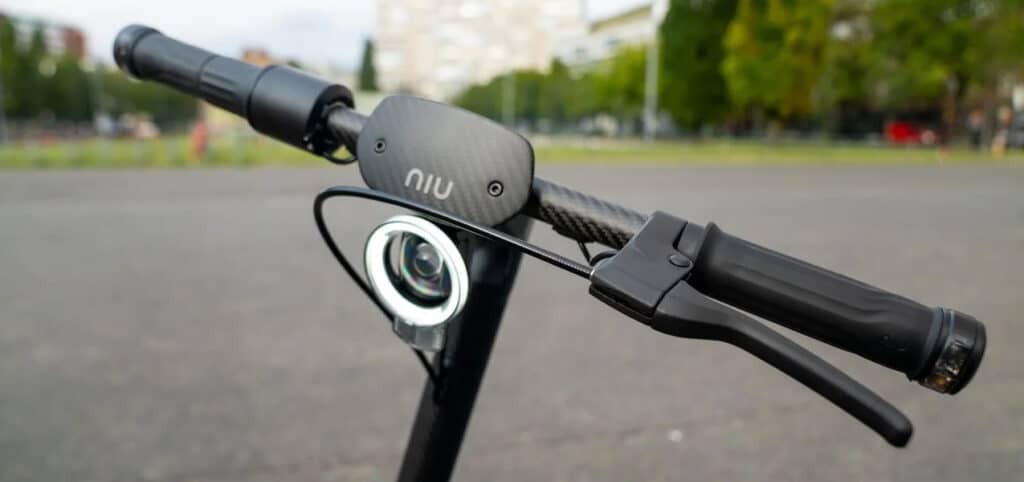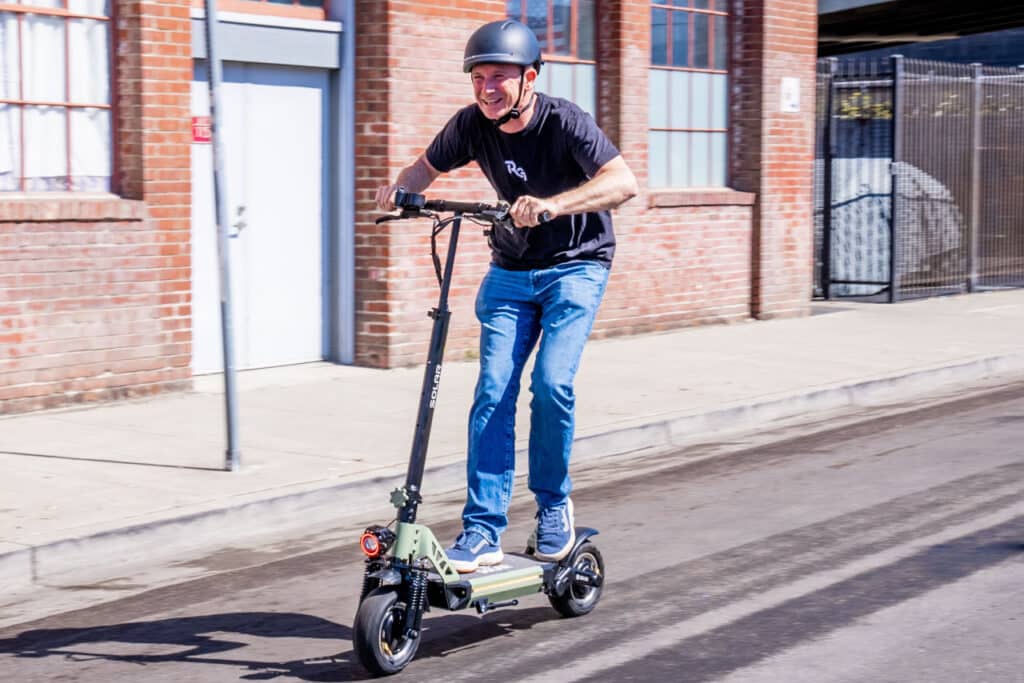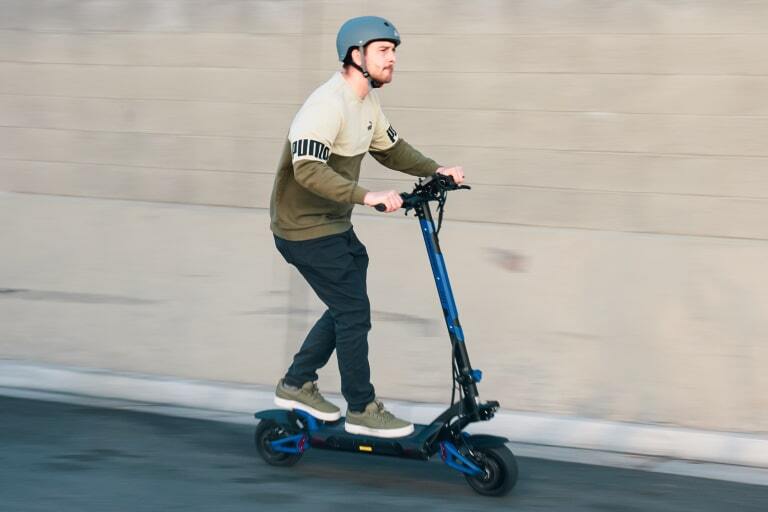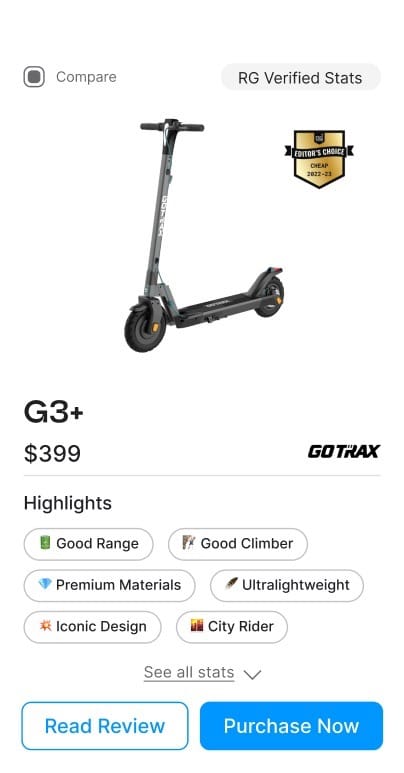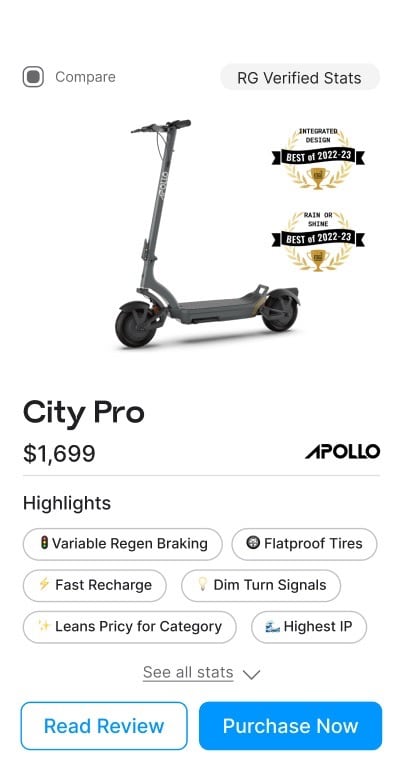
Paul Somerville
Rider Guide’s Editor-in-Chief is a seasoned expert in the electric scooter industry. With a wide-ranging background that includes managing scooter warehouses, selling thousands of motorcycles, and restoring high value (+1M) European sports cars, his expertise is unmatched. Having personally tested more than 100 electric scooters, he offers invaluable insights and recommendations to our readers. We are fortunate to have him as part of our team, as his diverse skill set and extensive experience ensure top-notch reviews.
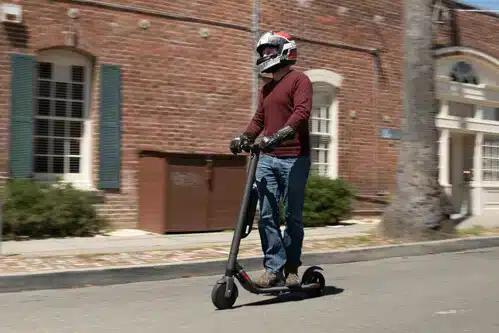
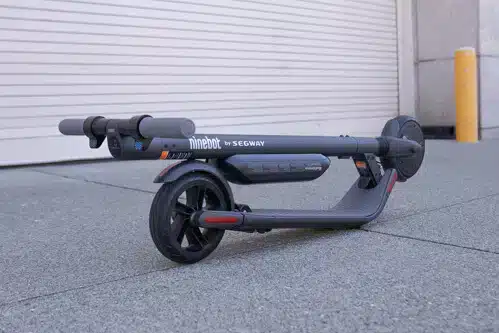

Segway Ninebot ES4 Summary


Technical Specifications
What Sets the Segway Ninebot ES4 Apart?
To be honest, not much, as it’s part of the ES series and is just as unexceptional as others in its family.
The ES4 has a utilitarian look and design, in shades of gray. It’s very easy to use and was the standard for the shared market for a reason — but has been upstaged by other scooters (including those from the Segway line-up).
The ES4 is well-built, fairly durable, and fast enough to navigate with others in traffic. Coming standard with dual batteries, the ES4 gets around 35% more range than the ES2 and goes 3 mph faster, with a tested top speed of 18.3 mph.
A couple of our favorite features of the ES4 are the ergonomic cockpit with comfortable, rounded handgrips and the fun under-deck (or swag) lighting. You can control the lights, including color schemes and patterns, with a Bluetooth-enabled mobile app.
It’s fast enough to keep up with bicyclists in traffic, and it’s shared market looks may keep others from stealing it. However, the ES4’s solid tires keep you from feeling any damping from the suspension, and make longer rides fairly uncomfortable.
Segway Ninebot ES4 Review
Perfomance Summary
Results below are based on our independent testing and not data provided by the manufacturer. Read about our testing methodology or compare with other scooters on our electric scooter performance testing page.
| Acceleration (0 to 15 mph) | 6.6 seconds |
| Top speed | 18.3 mph |
| Braking distance (15 to 0 mph) | 18.0 feet |
| Range | 15.3 miles |
| Hill climb | 19.7 seconds |
Acceleration
The Ninebot ES4 is very easy to handle. You do not need experience or finesse to accelerate from kickstart. It goes from 0 to 15 mph in 6.6 s. It’s not terribly slow but if you’re looking for a jumping start, this isn’t it.
Top Speed
The 18.3 mph tested top speed is just enough to feel fairly comfortable riding in traffic. It’s enough speed to let you pass bikers when sharing the bike lane, going up or down hill.
Hill Climb
The ES4 doesn’t fly up our 10% average hill, getting up the 200 ft incline in 19.7 s. However, it does a good job of maintaining an average 16 mph speed up a gentler, 6% grade.
Range

For a scooter with two batteries, we were surprised at the limited 15.3 mi range. Unfortunately, the solid tires on the ES4 made riding this distance feel more like 20 mi, as it’s not a scooter that you really want to spend that much time on at once.
Braking
The Ninebot ES4 comes with a regenerative brake and foot brake. For normal stop and go, the regen brakes are effective and really easy to use.

In an emergency stop, the rider will need to keep their rear foot free to hit the rear fender, which applies the foot brake. Using both brakes, the stopping distance was still just okay at 18.0 ft.
Considering the limited top speed, this braking is adequate but is around 7 ft more distance to stop than comparison scooters, like the Segway Ninebot Max (G30LP) which slows from 15 mph to 0 mph in 18.0 ft.
Compare with other scooters on our performance page.
Ride Quality
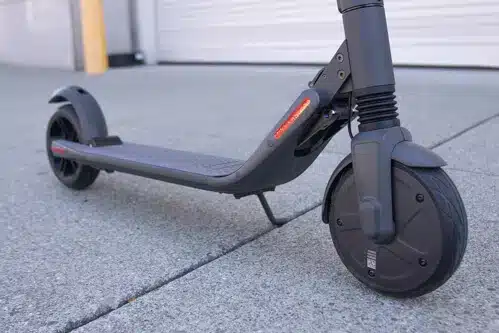
Although the ES4 comes with dual suspension, it doesn’t make up for the harshness of the solid tires. The front suspension clacks so loudly over sharp bumps that it can alarm nearby bicyclists (and the rider themself).
Riding ergonomics for the ES4 are good. With simple thumb controls for the brake and throttle, the rider can comfortably control the scooter while keeping both hands on the handlebars.
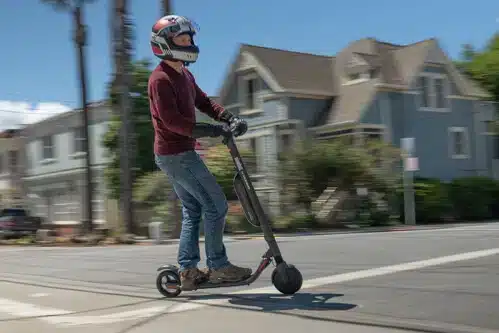
One surprising thing about the ES4 is that it feels very stable holding its 18.3 mph tested top speed. You won’t feel speed wobble at all, and abrupt inputs to the handlebars at speed resolve immediately.
With two batteries in the stem, the ES4 is a bit unwieldy when pushing the scooter up curbs and it doesn’t like rolling over bumps without falling forward, but this isn’t an issue when riding.

Lastly, the kickstand makes a loud, resounding clack when folding, which is great for letting the rider know it’s securely in place but is a bit of a jarring sound in quiet environments. It does its job well at keeping the scooter upright, and fits nicely into a pocket in the deck.
Segway Ninebot ES4 Features
Portability
With a fairly lightweight 31 lb build, the ES4 feels lighter than it is when you’re moving it around. The stem folds but doesn’t telescope and the handlebars don’t fold but are pretty narrow. It’s folded footprint is 45 in long by 17 in wide and 14 in tall.

The width of the handlebars keeps the package small and makes it easy to roll through doorways. A clasp on the step easily locks to the fender when folded for easier handling, but the wide stem makes it a little difficult to grip when trying to hold one-handed.
In the ES series, the internal battery is in the stem (rather than in the deck). As the ES4 also comes with an external battery, the scooter feels front-end heavy.

The folding mechanism consists of a flip-down tab that releases the stem. To fold, flip the tab down, then give slight forward pressure against the handlebars while stepping downward on the tab. A mechanism on the underside of the scooter will release the deck from the stem.
When upright, make sure the tab is flipped up, so you don’t accidentally fold the scooter while riding.
Cockpit
The cockpit of the ES4 is very simple, with thumb controls on either side of a round, single-button dashboard. The display is pretty easy to read, and allows the rider to power on, toggle through riding modes, and turn on the lights.

You can also pair your scooter with the Ninebot smartphone app via Bluetooth, and an icon will appear on the screen when connected. The app allows you to set functions, run firmware updates, control the lights, and lock the scooter, among other features.
Probably our favorite feature of the Ninebot ES4 is the large textured handgrips, which are indexed to the handlebars. This means they’ll stay in place as you’re riding, which is a simple but appreciated feature. They have a nice grippy feel, and the large diameter makes them easy to hold onto.
Lights

The Ninebot ES4 comes with fun lights for nighttime riding, as there is a high-mounted headlight, brake-sensing fender-mounted taillight, and under-deck swag lights (also known as road effects) that can be set to a variety of colors (through the app). There are also reflectors on the sides of the front of the deck, on either side of the rear wheel, and on top of the fender.
The headlight isn’t super bright, but the overall lighting package is a delightful surprise in an otherwise middling mid-range commuter scooter.
For riding a scooter at night, we recommend adding more lights, including another light to attach to the back of your helmet or backpack.
Tires

One of the most unforgiving things about the ES4 is the solid tires, which are among the worst out there. They are very stiff when riding over bumps, and the shallow tread means they don’t provide great traction and will wear out quickly.
On the plus side, the super hard rubber means you won’t get flat spots in your tires under hard braking, which can happen with solid tires made of softer material.
Deck

The deck is covered in thin rubber with a diamond-shaped pattern. It feels a little narrow and not especially long, and measures 6.0 in wide by 17.0 in long with 3.6 in of ground clearance. The deck isn’t super small, but there’s not much space for different standing positions.

The rear fender serves triple duty: first as a fender, second as a foot brake, and third as the anchor point when the scooter’s folded down. This is an excellent design that keeps the deck free of obstruction, as some scooters attach to the deck.
Build Quality

The Ninebot ES4 definitely fits within its family, with the same build as the others in the ES series and an overall solid build quality. One thing that Segway does better than other brands is cable management. There are zero exposed cables anywhere on the ES4, giving it a very clean look from top to bottom.
The ES4 is water resistance rated at IP54, but earlier versions were known to have motor controller failures due to water damage in the stem. As of June 2019, Segway encases the motor controllers in clear plastic to better guard against water.
The simple design also makes the scooter very easy to disassemble, as the handlebars are connected via a single plug-and-play connector.
Stem Bolts and Stem Wobble
The ES4 is durable, but its quality suffers from wear and tear long-term. Over time, the bolts at the left and right side of the top of the stem tend to loosen, in spite of generous application of loctite, causing a rocking forward/backward feel in the handlebars.

The base of the stem of the ES4 also tends to develop a wobble over time, from slippage between the mounting bolts and the stem itself. Newer Segway designs, like the Ninebot E22, have added another set of bolts at the top of the stem, facing the rider to firm up the handlebars. The ES4 design does not come with these reinforcing screws.
Regenerative Braking Limitations
While the regenerative brakes are very easy to use, having regen as the primary source of braking has limits. When the scooter is fully charged, descending a large hill while braking can cause the regen brake to stop functioning, as the battery is full and the energy has nowhere to go.
It also has the potential to cause the motor controller to overheat and fail. We strongly recommend using the foot brake when going downhill if your scooter’s fully charged.
Pros and Cons of the External Battery Pack

There are pros and cons to the external battery design. A great pro is that the charging port is at the top of the battery, so you don’t have to crawl on the floor to plug it in. The battery is screwed into the stem, so it isn’t easy for a thief to remove.
Also, there are charging ports on the battery and on the scooter’s stem beneath the battery, so if you have two chargers you could charge both individually.

One of the pros of the design is also a con in that the battery isn’t “swappable”.
On a model like the TurboAnt X7 Pro, you can purchase multiple batteries and extend your range easily, as the battery is held in place by a latch and it takes seconds to replace. If you wanted the same functionality with the ES4, you’d need to carry an allen wrench with you and take the time to unseat and reseat the screws for swapping.
Another con is that once the external battery is removed, the ES4 loses some of its range and a few miles off its top speed (basically congruent with the ES2’s performance).
Segway Ninebot ES4: Review Conclusions
The Ninebot ES4 is a scooter that’s very easy to use. It’s portable, can keep up with and pass bicyclists on the road, and comes with the build quality Segway has become known for.
However, it still doesn’t beat the Segway Ninebot Max, as it’s not the best in their lineup, and the overall performance and ride quality could really be better — especially given its price.
If the Segway line doesn’t fit your needs, check out our RG Editor’s pick of best electric scooters.
Segway Ninebot ES4 Manufacterer's Specifications
Note: This may differ from our tested specifications.
| Make | Segway |
| Model | Ninebot ES4 |
| Weight | 31 lb |
| Folded dimensions | 45 by 17 by 14 in |
| Motor power, continuous | 300 W |
| Top speed | 19 mph |
| Range | 28 mi |
| Battery capacity | 374 Wh |
| Battery recharge time | 7 hrs |
| Max rider weight | 220 lb |
| Brake type | Regenerative + Foot |
| Tire type | 8.0 in Solid + Solid |
| Built-in lights | Front + Rear |
| Water resistance | IP54 |





Related Reviews



